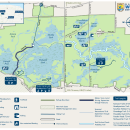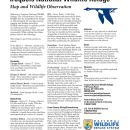Visit Us
Iroquois National Wildlife Refuge welcomes all!
The Refuge lands are open from sunrise to sunset.
Stop by the Visitor Center (Tuesday-Saturday, 9:00am-4:00pm, subject to change based on staff availability) to explore our exhibits and find helpful information including maps, brochures, birding checklists and restrooms. Binoculars and bird guides are available for loan, free of charge.
We are only able to issue the following America the Beautiful passes: Annual Military, Lifetime Veterans, Access Pass, and 4th Grader Pass. Federal Duck Stamps are also available for $25, cash only. Please call ahead and make an appointment to ensure there will be someone there who can issue a pass or duck stamp.
Iroquois National Wildlife Refuge offers opportunities for visitors to experience nature in all seasons. Whether you are a hunter, birder, trapper, educator, recreational enthusiast, or just hoping to learn more about the natural world, the refuge has something for everyone!
Location and Contact Information
About Us
Iroquois National Wildlife Refuge was established in 1958 primarily as a nesting, resting, feeding, and staging area for migratory waterfowl. Our goals are to provide high quality freshwater wetland migration stopover and breeding habitat; maintain the health and integrity of Oak Orchard Creek as well as its associated floodplain and wetlands; provide a diverse mix of grassland, shrubland and forested upland habitats; provide high quality recreation, education, interpretive, hunting, and fishing programs; and to enhance partnerships with local communities and organizations.
What We Do
At Iroquois National Wildlife Refuge, we are dedicated to conserving and enhancing diverse habitats to support a wide array of wildlife. From managing wetlands, grasslands, and forests to protecting migratory birds and other species, we implement science-based strategies to maintain ecological balance. Our conservation efforts include using specialized tools like water control structures, prescribed burns, and invasive species invasive species
An invasive species is any plant or animal that has spread or been introduced into a new area where they are, or could, cause harm to the environment, economy, or human, animal, or plant health. Their unwelcome presence can destroy ecosystems and cost millions of dollars.
Learn more about invasive species management. Through careful stewardship, we ensure that these habitats provide critical nesting, feeding, and migration stopover sites for wildlife.
Education and outreach are also central to our mission. We offer a variety of programs for all ages, from guided nature walks to hands-on activities and special events. These initiatives aim to foster a deeper connection between people and the natural world while promoting conservation values. In addition to habitat management and education, we enforce federal wildlife laws to protect both the refuge and its visitors. Our team works to create a safe environment for wildlife and ensure that recreational activities like hunting and fishing align with conservation goals.
Our Library
Here is a comprehensive list of documents and links that pertain to the refuge if you cannot find what you're looking for on our other pages.



